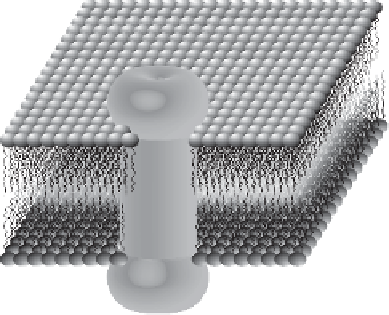Geoscience Reference
In-Depth Information
Cytoplasm
Mitochondria
s
Chloroplast
Figure 8.6
The major elements of a cell are the cytoplasmic liquid and the lipidic membrane. Eukaryotes
store their genetic material in the nucleus, which is also isolated from the cytoplasm by a
membrane. Energy conversion is ensured by mitochondria, probably a former symbiotic bacteria.
Chloroplasts are only present in plant cells and are used for photosynthesis.
Phosphoglycerides
(hydrophilic)
Fatty acids
(hydrophobic)
Membrane
protein
Figure 8.7
A simple membrane is made from a double layer of phospholipids, long molecules made from a
hydrophilic head of phosphoglyceride and a long tail of hydrophobic fatty acid. Large proteins are
used to ferry various components, such as H
+
or K
+
, through the membrane.
proteins, glucides, and about one percent of inorganic ions, notably K
+
,Na
+
,Mg
2
+
,Ca
2
+
,
Fe
2
+
,Cl
−
,PO
3
4
, and SO
2
4
. Again, the polynucleotides are a repository of PO
4
and amino
NH
2
groups, and nitrogen-containing cycles. We have already met the Redfield ratio which
states that the C:N:P proportions in plankton are in the proportions of 115:15:1.
Table 8.1
shows the inorganic composition of a sample of dry plankton material.




















































































































































































































































































































































































































































































































































































































